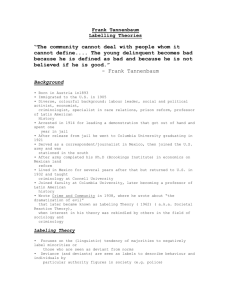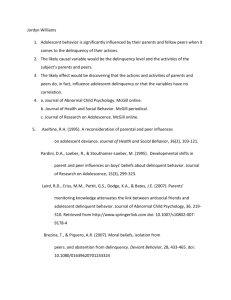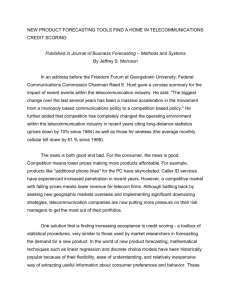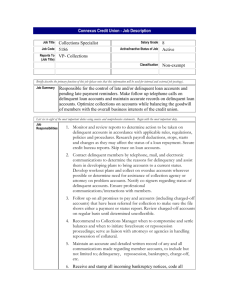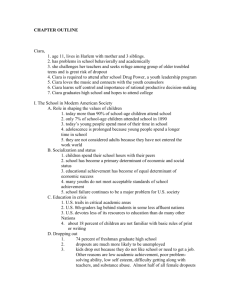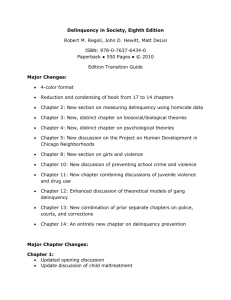Chapter 8 (powerpoint)
advertisement
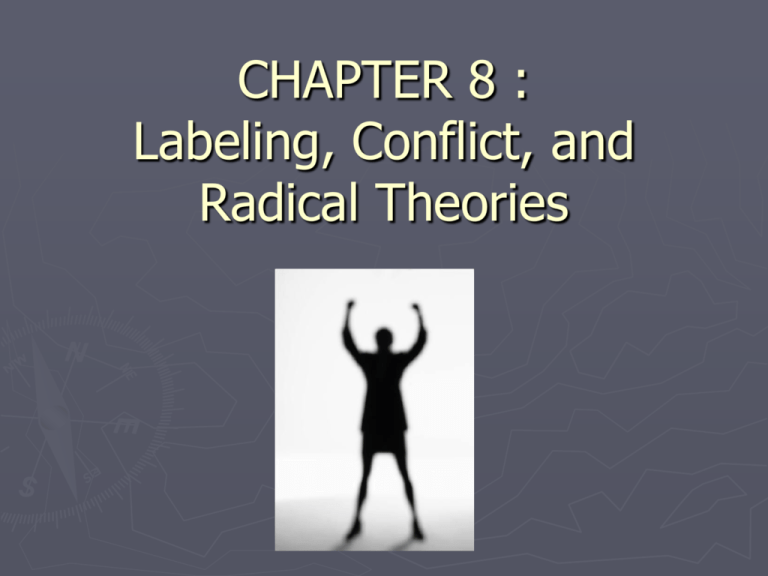
CHAPTER 8 : Labeling, Conflict, and Radical Theories WANT 3 QUICK EXTRA CREDIT POINTS? JUST CLICK HERE! • A. Introduction • 1) How does the labeling process, the role of conflicting forces, differential power and how adults exert their power affect delinquency in juveniles? • B. Labeling Theories • 1) Contrary to the theories of cultural deviance, strain and social control, labeling theory assumes that social control leads to deviance • a. Basic assumptions are that human nature is flexible and that social interaction trumps all (the socialization process is key) • b. Social response in the form of social control can lead to delinquent behavior • i. Labeling a child as a delinquent has negative connotations in itself (it has second and third order effects) • ii. The label of a delinquent may result in the child becoming a delinquent • 2) Frank Tannenbaum • a. Strongly rejected the notion of a dualistic fallacy in delinquency, or the belief that delinquents and non-delinquents are two completely separate entities Labeling Theory Original Delinquent Act Label Applied A Delinquent Self-Image Future Delinquency • i. Argued that delinquents are well adjusted members of society • ii. Delinquent activity begins as random play or adventure • iii. Societies response to such behavior may result in a label that carries substantial weight in determining the future behavior of a child • iv. The child may respond by living up to this label • v. Labeling a child as a delinquent isolates them from the rest of the community and may drive them to associate with similarly labeled individuals ► 3) Edwin Lemert a. Defined the deviant behavior that everyone partakes in occasionally as primary deviation ► i. Characteristics of this behavior: rationalized, social acceptable ► ii. How delinquency is defined under this primary deviation depends on how society responds to this deviant behavior ► iii. If the deviant behavior that is engaged in is highly visible, then it will difficult for the youth to hold onto their old role ► iv. The youth will be forced to choose a new role that is more or less deviant than the old role b. Secondary deviation is the deviant behavior that is based on the youth’s taking on and accepting the deviant role as part of his/her identity when they are forced to choose a new role c. The following is a sequence of interaction that leads to secondary deviance ► i. primary deviation ► ii. Social penalties ► iii. Further primary deviation ► iv. Stronger penalties & rejections ► v. Further deviations ► vi. Crisis reached in the tolerance quotient ► vii. Deviant behavior becomes more pronounced in a reaction to stigmatization by society ► viii. The juvenile accepts their deviant social status c. According to Lemert, a youth from a lower socio-economic status is more likely to accept this new role ► i. Parents who are powerless and poor are more likely to respond to delinquency by turning over the child to community agents such as the juvenile court system ► ii. Once labeled by the court system as a delinquent, the juvenile will likely have a negative self image of themselves which promotes recidivism d. Case Study- Willie Bosket ► 4) Howard Becker a. Argued that delinquents are not a homogenous group since some have been falsely accused, or have not broken any rules ► i. Conversely, others who have broken many rules and who have not been caught are referred to as secret deviants ► ii. Becker questioned whether criminologists were studying the right groups of people b. People acquire their labels, and deviance is a social construct which is dependant on society’s response to an act c. What is the process of becoming a delinquent? ► i. The child commits a deviant act, (whether intentional or not) ► ii. They get “caught” ► iii. The youth then acquires a new label, (thug, troublemaker, delinquent) ► iv. The stigma of this label may influence the juvenile to engage in other acts of delinquency (society expects them to) d. Being labeled as a delinquent functions as a master status, or a status that takes precedence over all other statuses or characteristics of the individual ► ► i. If a juvenile is labeled as a ‘delinquent’ this may be a self-fulfilling prophecy ► ii. This master status may result in ‘conventional’ people severing ties with the youth, thus leading to increased deviance as a result of social expectations ► iii. Becker says that the final stage of this process is when the juvenile labeled as a delinquent seeks out others with a similar label which may lead to the formation of street gangs 5) Edward Schur a. Emphasized the idea of radical nonintervention, or the notion that since the labeling process involves nothing more than outrageous stereotypes, society should try to “leave kids alone whenever possible” ► i. Since there is a certain degree of retrospective interpretation in the juvenile justice system, all children can effectively be classified as delinquents ► ii. Schur argues that most delinquency is insignificant and copasetic and should not be punished by society ► iii. If a youth seriously violates the norms of society, they should be rehabilitated through programs that won’t stigmatize them, rather than being committed to a correctional facility ► 6) John Braithwaite a. Extended the basic labeling theory by exploring the nature and the impact of shaming ► ► i. Shaming takes two forms, the first being disintegrative, (A form of negative labeling by the juvenile justice system that stigmatizes and excludes targeted youths, tossing them into a class of outcasts) ► ii. The second form of shaming called re-integrative, (or the expression of community disapproval of delinquency, followed by indications of forgiveness and reacceptance into the community) ► iii. Braithwaite theorizes that disintegrative shaming is counter-productive and instead condones the use of re-integrative shaming ► iv. The emphasis should be on condemning the act and not the actor 7) Critiques of Labeling Theory a. Though preliminary studies by William Chambliss identified a link between labeling a child as a delinquent and the child later adhering to that role, Charles Tittle and Robert Meier argue that recidivism is not necessarily caused by strong social controls ► i. Other studies conducted by Charles Thomas and Donna Bishop found that applying sanctions to offenders does not necessarily push them toward the acceptance of a deviant label ► ii. Jack Foster and other researchers found that youths who were subjected to labels did not seem to feel that it made much of a difference, (evidence suggest that it had little effect on their self-esteem) b. However, there has been some support for the labeling theories ► ► i. Research by Karen Heimer and Ross Matsueda note that delinquency is produced by interactions between the youth and a referenced delinquent group or conventional others and those factors such as motives, norms, attitudes and gestures coalesce into a self-reflected delinquent identity ► ii. Heimer also speculated that there is a gender gap in delinquency (more male delinquents than females) because the meaning of behavior varies across gender ► iii. The way in which delinquent groups or conventional others are referenced is different among the sexes ► iv. Labeling theory was also supported by Malcolm Klein after studies he conducted in the 1980’s found that some youths participate in delinquency in response to having an official record (label) 8) Policy Applications of Labeling Theory a. Research has shown that having an official label applied to a mild offender can have negative effects b. Since the core of labeling theory suggests that intervention by the juvenile justice system instills deviant self-identification in an offender, what role should such institutions play? ► i. Ignore the delinquent acts? ► ii. Should the reaction by the juvenile justice system be limited, only intervening when absolutely necessary? ► iii. Is the Edwin Schur policy of radical non-intervention practical? c. Police ‘diversion’ programs such as the Big Brother/Big Sister Club and the Police Athletic Club (PAL) were once widely used methods of rehabilitation in the 1970’s but their effectiveness has often been questioned ► i. Do diversion programs serve to deter delinquency? d. Of all of the theories mentioned thus far in this chapter, John Braithwaite’s idea of re-integrative shaming seems to be embraced by policy makers the most, but how do we apply it? ► i. Informal agencies or institutions of social control should express their disapproval of the delinquent act (remember, the focus here is on the act and not the actor) ► ii. Integrate the repentant role through programs of rehabilitation ► iii. Media coverage should not only focus on delinquent acts, but should also focus on individual offenders who were successfully rehabilitated (who can be used as examples) ► C. Conflict Theory ► 1) Conflict Theory views conflict within society as normal and rejects the idea that society is organized around a consensus of values and norms a. Conflict theorists believe that society is held together by force, coercion, and intimidation ► ► i. Marxist conflict theory views capitalism as the root of crime and that the efforts of the ruling class to repress the ruled class results in delinquency 2) Karl Marx and Friedrich Engels a. Since the bourgeoisie control the means of production and the proletariats sell their labor to the bourgeoisie, conflict will result ► i. The bourgeoisie’s control extends into other facets of society as well including the production of ideas ► ii. According the Marx and Engels, the police, courts and correctional system of society is yet another tool of the bourgeoisie to control the working class (proletariat) Conflict Theory Capitalism Class Divisions Ruling Class defines what behavior will be delinquent Delinquency by lower-class adolescents b. The capitalist system by design can lead to a demoralized working class which can result in delinquency ► ► i. Criminals and their juvenile counterparts, called the ‘lumpenproletariat’ (dangerous class) make their living by picking up the crumbs of capitalist relations of exchange 2) Thorsten Sellin & George Vold a. Thorsten Sellin made a distinction between crime norms (the rules that prohibit specific conduct and provide punishments for violations) and conduct norms (the values, expectations, and actual behaviors of groups in everyday life) ► i. Conduct norms do not necessarily reflect criminal law and group norms may directly conflict with crime norms ► ii. Delinquency will be higher in areas with the greatest diversity of group norms b. George Vold argues that as new interests arise, new groups are formed ► ► i. Groups conflict when their interests overlap or become competitive ► ii. Whichever group can influence the legislative process the most will likely obey the new laws while those with little power may have the behavior that reflects their interests, labeled as criminal 3) Robert Regoli and John Hewitt a. Regoli/Hewitt developed the differential oppression theory, which argues that delinquency is the culmination of a process that begins at conception and evolves through adolescence; the more a child is oppressed, the greater the likelihood he or she will become delinquent ► i. Compared to adults, children have little or no power ► ii. Oppressive acts against children tend to force children to accept their status as oppressed persons ► i. Adults emphasize order in the home and school b. There are four major principles to differential oppression ► ii. Adults see children as inferior subordinate beings and as trouble makers Differential Oppression Theory Order Perceptions Stereotypes of Children as Inferior Imposing Order Conflict Oppression Passive Acceptance Use of Illegitimate Coercive Power Manipulate Peers Retaliation ► ► iii. The imposition of adult ideals of order on children may become oppressive in nature ► iv. Oppression leads to adaptive reactions by children, namely: passive acceptance, exercise of illegitimate coercive power, manipulation of ones peers and retaliation 4) Critiques of Conflict Theory a. Are conflict theories nothing more than traditional liberal approaches to helping the underdog? ► i. Jackson Toby claims that crime is typically not committed for survival, but for wealth and do not usually produce testable hypotheses ► iii. Francis Allen and David Shichor argue that conflict theory exaggerates the political and economic nature of juvenile delinquency b. Donald Shoemaker criticizes conflict theory on the grounds that: ► i. Delinquency is not restricted to the ‘underdog’ ► ii. Juveniles don’t seem concerned with their position in the economic system ► iii. Racial and ethnic factors have more of an influence on crime than social factors do ► iv. Difficult to establish a link between Capitalism and demographic conditions within a society c. Even though the subordinated groups may be more involved in delinquency, why are males more likely to be involved in delinquency than females? ► 5) The policy applications of conflict theory a. Conflict theory has not had much of an impact on public policy ► i. Policy changes that implement conflict theory would require a shift towards socialism and the restructuring of many governmental and social institutions b. Despite their shortcomings in practical application, conflict theories have sparked considerable debate among criminologists and society in general ► D. Radical Theory ► 1) Mark Colvin and John Pauly a. Their theory of “integrated structural-Marxism” contends that serious delinquency is the result of coercive patterns of control learned under a repressive capitalist society and applied to juveniles ► ► i. Lower class parents learn these coercive patterns of control in the work place ► ii. Since these adults feel powerless in the workplace they displace their feelings of alienation by using these methods of control on their children ► iii. This can lead to conformist behavior by children, or it can lead to delinquency 2) Left Realism a. A direct response to the Marxist and Neo-Marxist views that crime and delinquency were committed for survival b. Instead, Left Realists felt that crime was committed by the working class so that they could indulge in the same pleasures and material wealth as the powerful capitalists ► 3) Critiques of radical theory and possible policy applications a. Researchers such as Marvin Krohn, Steven Messner, Sally Simpson and Lori Elis have found that the relationship between social class and delinquency is largely structured by gender b. Left realism has been criticized for being overly simplistic and for overlooking the racist and sexist divisions within neighborhoods that put groups in conflict c. Similar to conflict theories, radical theories are also difficult to test and have had little impact on public policy ► ► i. However, left realists emphasize the need for participatory democracy, job creation and activism in society ► ii. Radical Theorists also call for reductions in tough criminal penalties, similar to the liberal reform policies that have been advocated since the 1960’s -end of chapter 8 notes

